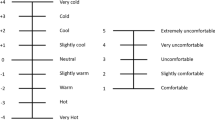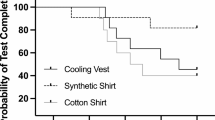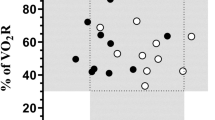Abstract
This study investigated whether wearing common white sportswear can reduce heat stress more than being semi-nude during exercise of different intensities performed under radiant heat and wind conditions, such as a hot summer day. After a 20-min rest period, eight male subjects performed three 20 min sessions of cycling exercise at a load intensity of 20 % or 50 % of their peak oxygen uptake (VO2peak) in a room maintained at a wet bulb globe temperature (WBGT) of 28.7 ± 0.1 °C using two spot lights and a fan (0.8 m/s airflow). Subjects wore common white sportswear (WS) consisting of a long-sleeved shirt (45 % cotton and 55 % polyester) and short pants (100 % polyester), or only swimming pants (SP) under the semi-nude condition. The mean skin temperature \( \left(\overline{T} sk\right) \) was greater when subjects wore SP than WS under both the 20 % and 50 % exercise conditions. During the 50 % exercise, the rating of perceived exertion (RPE) and thermal sensation (TS), and the increases in esophageal temperature (ΔTes) and heart rate were significantly higher (P < 0.001–0.05), or tended to be higher (P < 0.07), in the WS than SP trials at the end of the third 20-min exercise session. The total sweat loss (m sw,tot) was also significantly higher in the WS than in the SP trials (P < 0.05). However, during the 20 % exercise, the m sw,tot during exercise, and the ΔTes, RPE and TS at the end of the second and third sessions of exercise did not differ significant between conditions. The heat storage (S), calculated from the changes in the mean body temperature (0.9Tes + 0.1 \( \overline{T} sk \)), was significantly lower in the WS trials than in the SP trials during the 20 min resting period before exercise session. However, S was similar between conditions during the 20 % exercise, but was greater in the WS than in the SP trials during 50 % exercise. These results suggest that, under conditions of radiant heat and wind at a WBGT greater than 28 °C, the heat stress associated with wearing common WS is similar to that of being semi-nude during light exercise, but was greater during moderate exercise, and the storage of body heat can be reduced by wearing WS during rest periods.






Similar content being viewed by others
References
Adams WC, Mack GW, Langhans GW, Nadel ER (1992) Effects of varied air velocity on sweating and evaporative rates during exercise. J Appl Physiol 73:2668–2674
Benzinger TH (1959) On physical heat regulation and the sense of temperature in man. Proc Natl Acad Sci USA 45:645–659
Bröde P, Kuklane K, Candas V, Hartog EA, Griefahn B, Holmér I, Meinander H, Nocker W, Richards M, Havenith G (2010) Heat gain from thermal radiation through protective clothing with different insulation, reflectivity and vapour permeability. Int J Occup Saf Erg 16:231–244
Clark JA, Cena K (1978) Net radiation and heat transfer though clothing: the effects of insulation and color. Ergonomics 21:691–696
Dennis SC, Noakes TD (1999) Advantages of a smaller body mass in humans when distance-running in warm, humid conditions. Eur J Appl Physiol Occup Physiol 79:280–284
Farnworth B (1983) The mechanisms of heat flow through clothing insulation. Tex Res J 53:717–727
Fountain ME, Arens EA (1993) Air movement and thermal comfort. ASHRAE J 35:26–30
Furuya T, Kubota T (1975) Physiological reaction of men under exercise to radiant heat. Bull Tokyo Med Dent Univ 22:79–92
Gagge AP, Nishi Y (1977) Heat exchange between human skin surface and thermal environment. In: Lee DHK (ed) Handbook of physiology. American Physiological Society, Bethesda
Gavin TP (2003) Clothing and thermoregulation during exercise. Sports Med 33:941–947
Gavin TP, Babington JP, Harms CA, Ardelt ME, Tanner DA, Stager JM (2001) Clothing fabric does not affect thermoregulation during exercise in moderate heat. Med Sci Sports Exer 33:2124–2130
Hartog EA, Havenith G (2010) Analytical study of the heat loss attenuation by clothing on thermal manikins under radiative head loads. Int J Occup Safety Erg 16:245–261
Hassan M, Qashqary K, Hassan HA, Shady E, Alansary M (2012) Influence of sports fabric properties on the health and performance. Fibres Text Eastem Europe 20 4(93):82–88
Ishizaki Y (1978) Advanced wind engineering. Asakura-Shoten, Tokyo: 31
Japan Sports Association (2008) A guidebook for the prevention of heat disorders during sports activities. Nippon International Agency, Tokyo: 12
Kwon A, Kato M, Kawamura H, Yanai Y, Tokura H (1998) Physiological significant of hydrophilic textile materials during intermittent exercise in humans under the influence of warm ambient temperature with and without wind. Eur J Appl Physiol 78:487–493
McCullough EA, Jones BW (1984) Institute for environmental technical report: a comprehensive database for estimating clothing insulation. Kansas State University Press, Manhattan, pp 84–101
Mekjavic IB, Rempel ME (1990) Determination of esophageal probe insertion length based on standing and sitting height. J Appl Physiol 69:376–379
Mitchell JW, Nadel ER, Stolwijk JAJ (1972) Respiratory weight loss during exercise. J Appl Physiol 32:474–476
Nadel ER, Michell JW, Stolwijk JAJ (1973) Differential thermal sensitivity in the human skin. Pfugers Arch 34:071–076
Nagamine S, Suzuki S (1964) Anthropometry and body composition of Japanese young men and women. Hum Biol 36:8–15
Nagata H, Yoneda Y (1966) Effects of the wet clothing in the hot environment. Ind Heal 8:381–384
Nakai S, Yorimoto A, Morimoto T (1990) Environmental temperature of an athletic field in Japan and comparison between wet bulb temperature and WBGT (Wet Bulb Globe Temperature). Jpn J Phys Fit Sports Med 39:120–125
Nakai S, Yorimoto A, Morimoto T (1992) The relation between environmental conditions and the occurrence of exertional heat disorders during physical activity. Jpn J Phys Fit Sports Med 41:540–547
Nakai S, Sinzato K, Morimoto T (1996) Epidemiological analysis of heat disorders in Japan. Jpn J Biometeorol 33:71–77
Nakai S, Sin-ya H, Yosida T, Yorimoto A, Inoue Y, Morimoto T (2007) Proposal of new guidelines for prevention of heat disorders during sports and daily activities on age, clothing and heat Acclimatization. Jpn J Phys Fit Sports Med 56:437–447
Nielsen B (1990) Solar heat load: heat balance during exercise in clothed subjects. Eur J Appl Physiol 60:15–25
Onodera K, Miyashita M (1976) A study on Japanese scale for rating of perceived exertion in endurance exercise: rating of perceived exertion. Jpn Phys Educ Health Sport Sci 21:191–203
Pascoe DD, Shanley LA, Smith EW (1994) Clothing and exercise. Sport Med 18:38–54
Rodriguez RM (2012) Influence of aerobic fitness on thermoregulation during exercise in the heat. Exer Sports Sci Rev 40(2):79–87
Sakai K, Mase K (1991) A basic study of thermal physiology: a comfortably-analysis of differential forms in clothing. Bull Nagoya Wom Univ 37:21–29
Shin-ya H, Yosida T, Tuneoka H, Nakai S, Itou T (2004) Effect of sports wear on thermoregulatory response during exercise in a hot environment. Jpn J Phys Fit Sports Med 53:347–356
Sin-ya H, Yosida T, Touneoka H, Nakai S, Itou T (2005) Effect of varying skin temperature due to several types of clothing on temperature responses and heat-stress during exercise. Jpn J Phys Fit Sports Med 54:259–268
Smith BF, Block I (1982) Natural fiber. In: Tauber H (ed) Textile in perspective. Prentice-Hall, Englewood Cliffs, pp 70–156
Watanuki S, Hiraoka M, Doi T, Kiyokawa H (1992) Physiological evaluation of clothing made of new material for protection against the solar heat load. J Physiol Anthropol 11:585–592
Yaglou CP, Minard CD (1957) Control of heat casualties at military training. Am Med Ass Archs Ind Health 6:302–316
Yorimoto A (1992) Physiological evaluation of WBGT index during exercise in heat. Jpn J Phys Fit Sports Med 41:477–484
Yoshida T, Takanishi T, Nakai S, Yorimoto A, Morimoto T (2002) The critical level of water deficit causing a decrease in human exercise performance: a practical field study. Eur J Appl Physiol 87:529–534
Young AJ, Sawka MN, Epstein Y, Decristofano B, Panddolf KB (1987) Cooling different body surfaces during upper and lower body exercise. J Appl Physiol 63:1218–1223
Author information
Authors and Affiliations
Corresponding author
Rights and permissions
About this article
Cite this article
Tsuji, M., Kume, M., Tuneoka, H. et al. Differences in the heat stress associated with white sportswear and being semi-nude in exercising humans under conditions of radiant heat and wind at a wet bulb globe temperature of greater than 28 °C. Int J Biometeorol 58, 1393–1402 (2014). https://doi.org/10.1007/s00484-013-0722-3
Received:
Revised:
Accepted:
Published:
Issue Date:
DOI: https://doi.org/10.1007/s00484-013-0722-3




